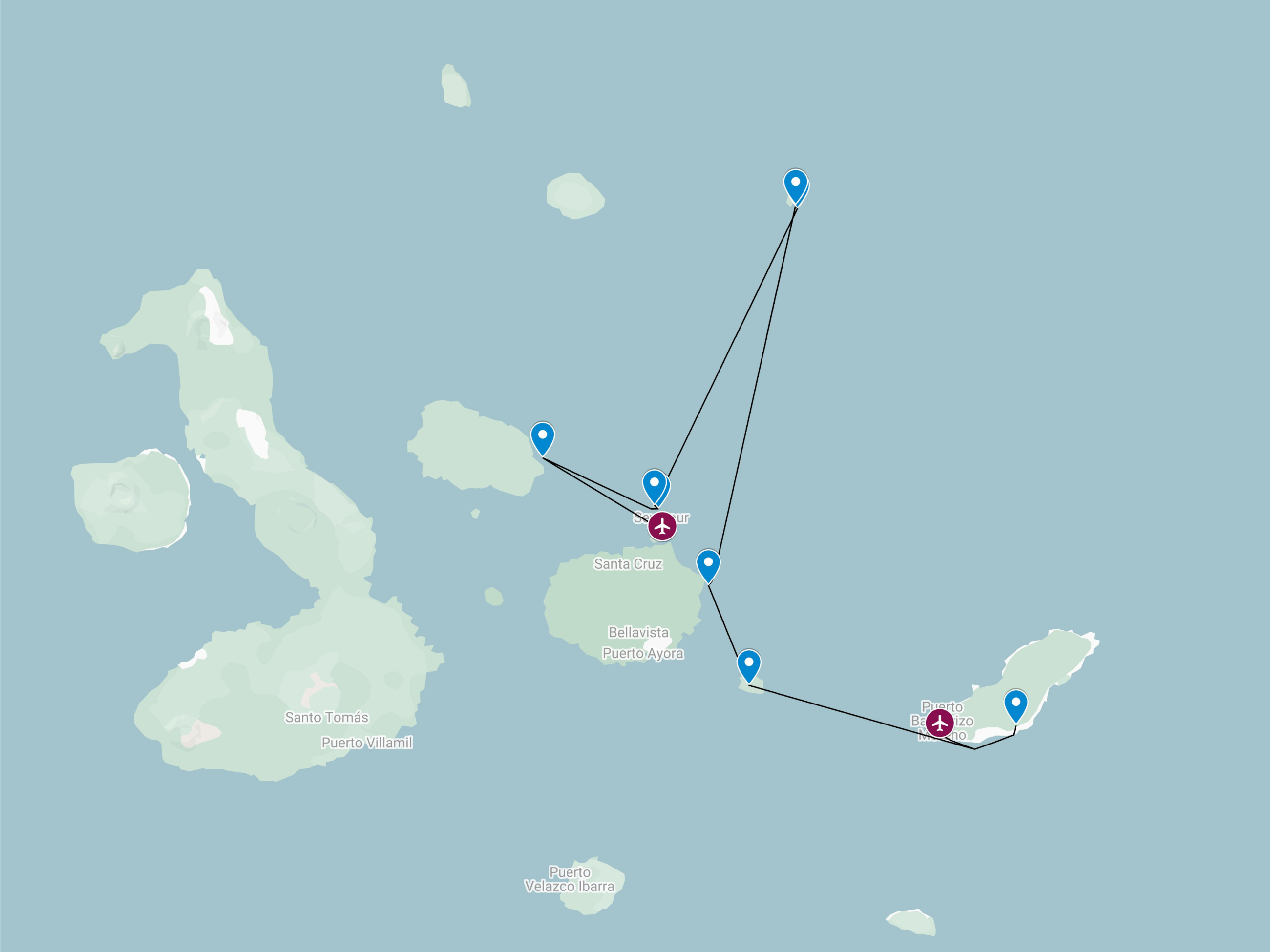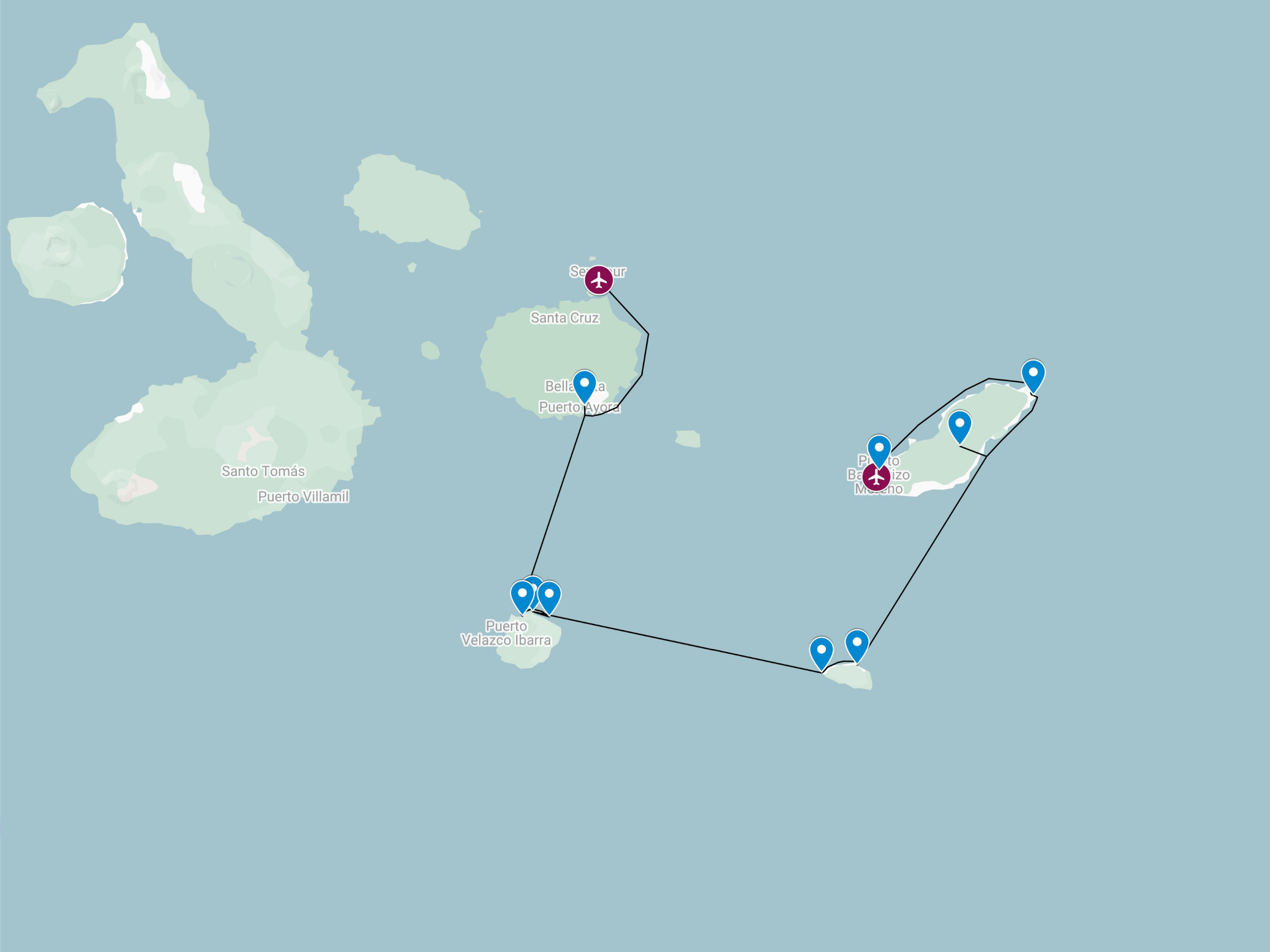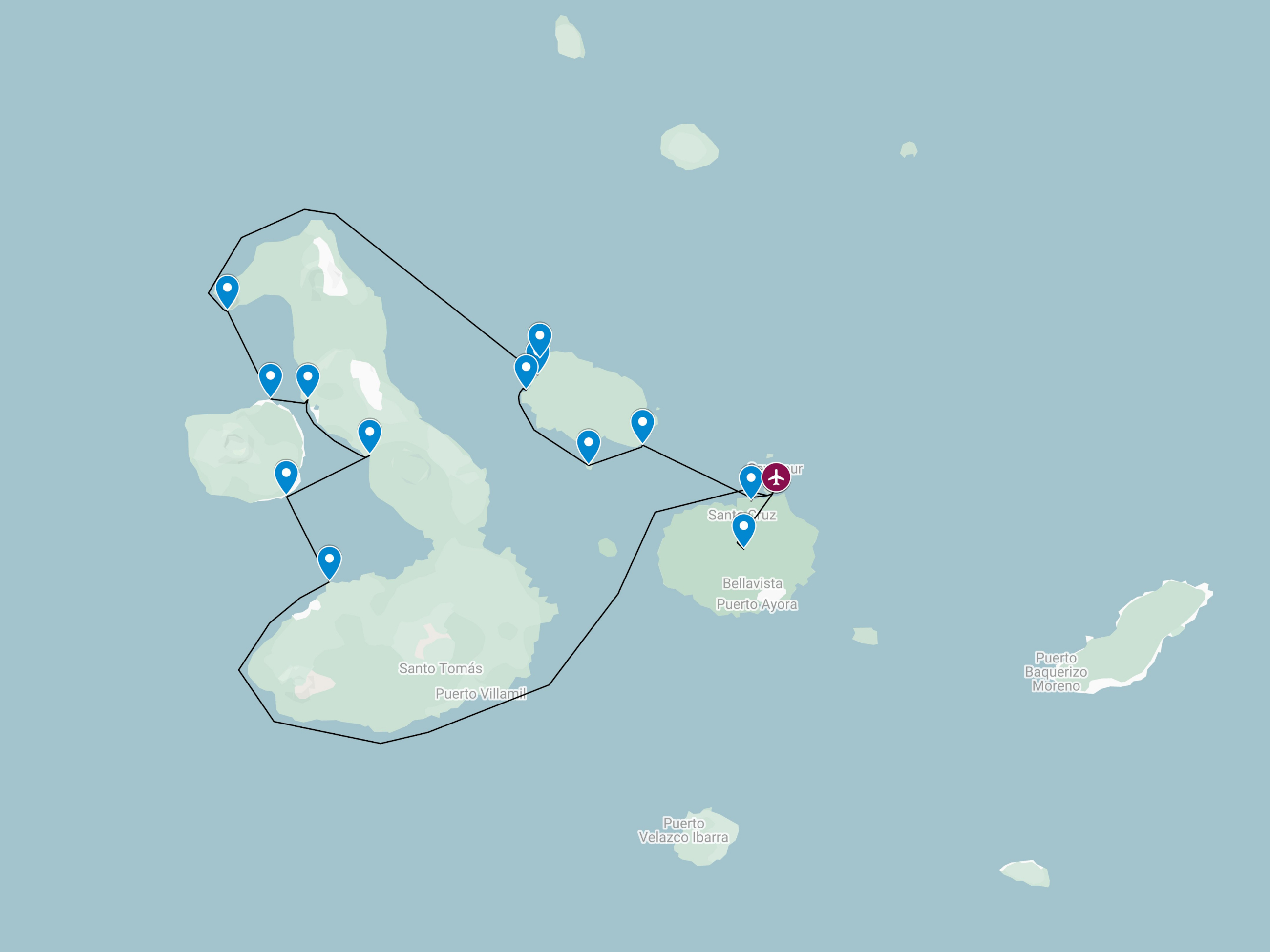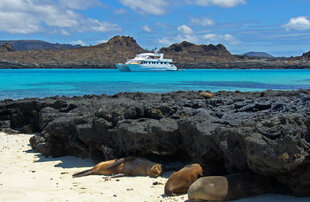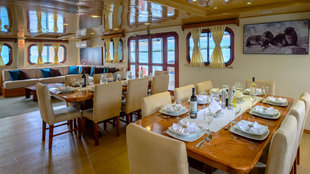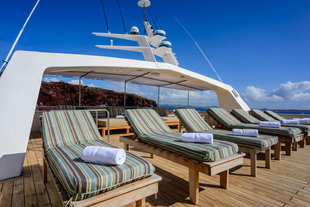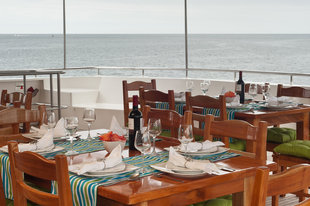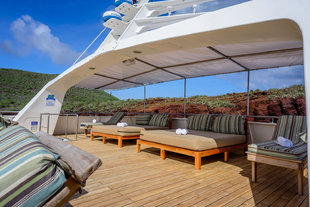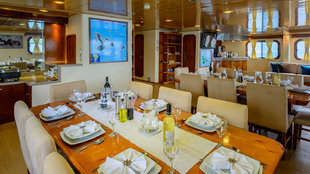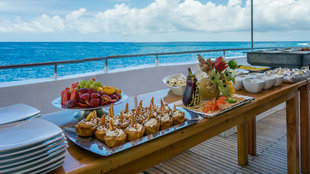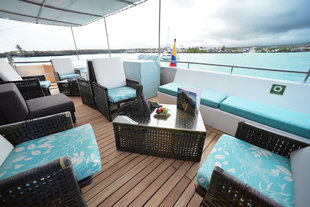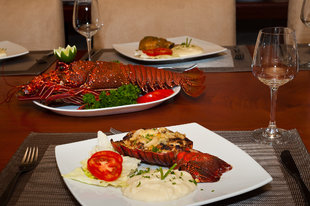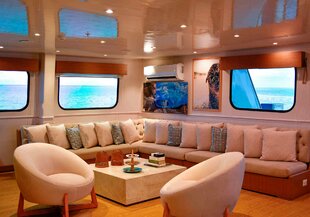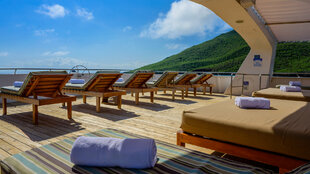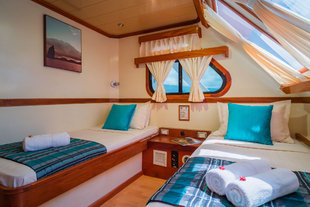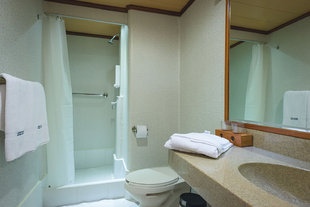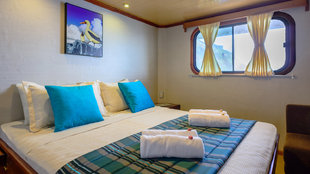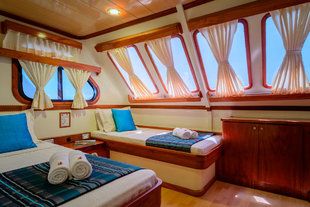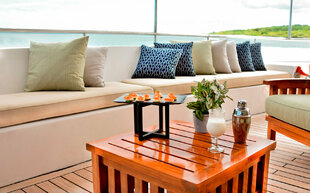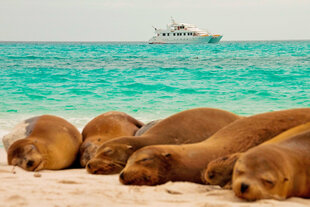Galapagos Seaman Journey is a first class catamaran that began sailing the Galapagos Islands in January 2008. She is a first class expeditionary catamaran offering superior comfort, size, style, and stability. She makes it possible to enjoy several cruises in the Galapagos with different itineraries that include amazing land tours on most of the Galapagos Islands. During these Galapagos Cruises, there are opportunities to encounter many endemic species like Galapagos Giant Tortoises, Penguins, Land and Marine Iguana's, Frigate Birds, Blue Footed Boobies, and much more!
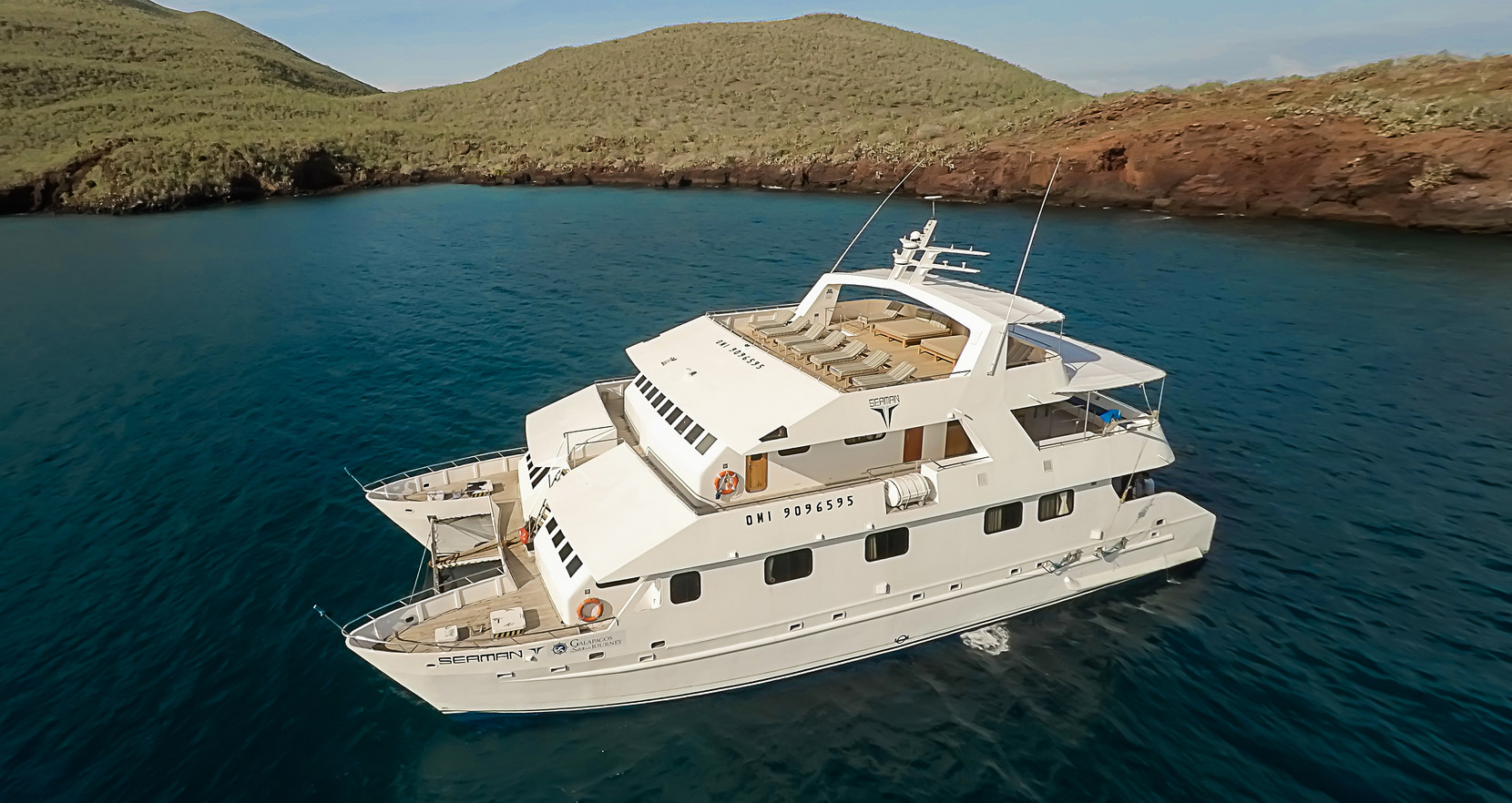
During the cruises each guest can enjoy the well-furnished areas offering comfort and privacy. With a maximum capacity of 16 passengers, this vessel offers both intimacy and camaraderie at the same time. There are several resting areas for those who are looking for a quiet place to relax during their Galapagos trip with family and friends in the lazy mid-afternoon sun, or likewise after a busy day of swimming, snorkelling, kayaking, or walking on one of the Galapagos Islands.
Whether you feel like soaking up some sun, relaxing with fellow passengers or simply want to pitch up to enjoy the gorgeous sunsets over the Galapagos Islands, the sundecks are the ideal place to be. For those with a thirst for knowledge, a look in the "book nook", the onboard mini-library is always available with a few books about Galapagos that complement what they have seen and experienced during the trip. For those who might want to relax and kick back, there is a bar and lounge area where the bartender will happily serve you a cool drink of your choice.
Technical Specifications
| Type | Motor catamaran |
| Year built | 2007 |
| Category | Boutique yacht naturalist liveaboard |
| Engines | 2x Cummins 350 IMO |
| Generators | 2x 50 kW IMO |
| Material | Fibreglass |
| Electricity | 110V & 220V AC/DC |
| Cruising speed | 10 knots |
| Length | 90 ft / 27.6 m |
| Beam | 36 ft / 11 m |
| Draft | 4.75 ft / 1.45 m |
| Water capacity | 3,000 gallons |
| Diesel capacity | 2,500 gallons |
| Guest capacity | Maximum 16 |
| Crew | 9 |
| Equipment | Snorkelling gear & sea kayaks |
Deck Plan
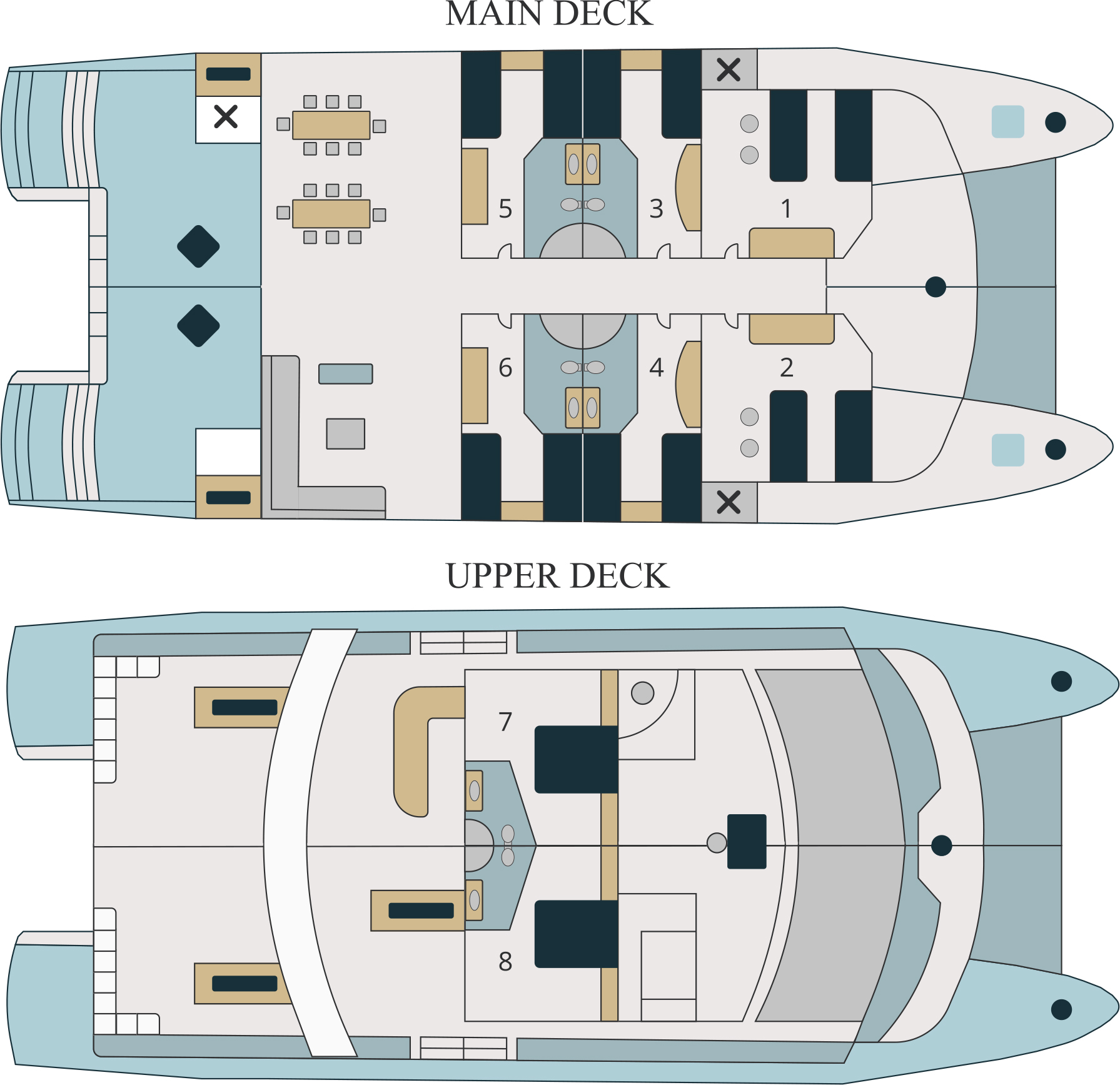
Itinerary
Each itinerary is designed as just a single part of your Galapagos experience and are combinable. We recommend combining itineraries for a more comprehensive visit to the Galapagos Islands.
Please note that these itineraries are subject to change without notice due to seasonal changes, last minute weather conditions and the decision of the Galapagos National Park authority.
Day 1 (Thursday) – Arrival & Bartolomé
AM: Arrival, Baltra Island
Upon arrival Baltra, travellers pass through an airport inspection point to make sure that no foreign plants or animals are introduced to the islands, and to pay the park entrance fee of $200 (unless it has been prepaid). A guide will meet you, help you collect your luggage and escort you on a short bus ride to the harbour.
PM: Isla Bartolomé
One of the Galapagos’ most iconic locations, the beautiful volcanic islet of Bartolomé is among the youngest islands in the archipelago. On a geological scale Bartolomé was only recently born out of volcanic activity. Although at first sight lifeless, Bartolomé offers some of the wildest landscapes and best panoramas of the entire archipelago. To enjoy the postcard view of the idyllic Pinnacle Bay, you have to climb steps to a viewpoint on top of the island (114 m / 375 ft). Enter a dramatic world of threatening (though extinguished) nearby spatter cones, craters, and lightweight lava droplets that have been spewed out by fiery fountains. The Summit Trail is also ideal for witnessing how scanty pioneer vegetation such as lava cacti manage to take root on the bare virgin lava fields.
Day 2 (Friday) – Mosquera & North Seymour
AM: Islote Mosquera
Mosquera is a low white sand island which lies in the Itabaca Channel between Baltra Island (South Seymour) and North Seymour. It is surrounded by coral reefs, providing protected conditions for snorkelling and scuba diving. Above water, it has a large sealion colony and is good for spotting birds like America oyster catchers, blue-footed boobies and lava gulls.
PM: Isla Seymour Norte
This islet is one of most visited sites in the Galapagos and it is teeming with birdlife. An easy circular path takes you through the archipelago’s most extensive colonies of blue-footed boobies and frigate birds. At the beginning of the breeding season, adult frigatebird-males blow up their vivid red pouches (gulas) to impressive football-sized balloons. This is one of the few spots where you can compare the magnificent and the great frigatebird breeding next to each other.
You are likely to come across several land iguanas on North Seymour, and the coast can be a good place to spot Galapagos sealions.
Day 3 (Saturday) – Prince Philip’s Steps & Darwin Bay
AM: El Barranco, Genovesa Island
Before landing, you will take an inflatable dinghy-ride along the eastern arm of the caldera. As we approach, the soaring 25 m / 80 ft high walls become overwhelming. Sometimes, a Galapagos fur seal is resting or a seabird is nesting on one of the ledges at the base. You will then have to hike and overcome the steep stairs from the landing dock to a bush of palo santo shrubs on top. Red-footed boobies gratefully use these scarce nesting places so that they don’t have to nest on the rocky ground. Upon arriving at the edge of the rim, the bushes open up and you can enjoy panoramic views, a sea breeze and the amazing flying skills of countless seabirds. Following the exposed rim, you will first pass a place where we usually encounter a colony of Nazca boobies; and finally reach the extensive storm petrel nesting places. If you are lucky, you can spot the well camouflaged short-eared owl hunting for them on foot!
PM: Darwin Bay, Genovesa Island
Inside the submerged caldera of Genovesa lies Darwin Bay, whose diameter is more than 1.5 km (1 mile) and it is almost 200 m (650 ft) deep. The small area will surprise you repeatedly, walking along a coral sand beach, crossing barren lava formations and creeks, passing tidal pools, shrubs and further ahead following the top of some cliffs. With this peaceful surrounding, every species has occupied its own ecological niche (or habitat) without disturbing others. There is great birdlife here with starring species including Red-Footed Boobies, Great Frigatebirds & Laval Gulls. These often share the beach with Galapagos Sea Lions.
Day 4 (Sunday) – South Plaza & Santa Fe
AM: Isla Plaza Sur
South Plaza is a beautiful island formed out of lava which bubbled up to the sea surface. It is relatively small but very diverse in its botany and very good for spotting Land Iguanas. hybrid Iguanas exist here, created through the mating of male marine iguanas and female land iguanas.
There are approximately 1,000 Galapagos Sealions on the island and birdlife is plentiful. Cliffs on the western side are nesting sites for Blue-footed and Nazca Boobies, whilst we can find Darwin's Finches amongst the rocks of the eastern side, Lava Gulls and lovely Swallow-tail Gulls. Red-billed Tropicbirds often swoop low overhead, whilst in the sea beneath the western cliffs we can often see schools of fish close to the surface.
This island can be one of the best for photography.
PM: Isla Santa Fé
Located in the southeastern part of the Galapagos, this island was formed from an uplift rather than being from a volcanic origin, which is why it is mostly flat. There are some theories claiming that this could be the oldest island in the archipelago. Santa Fé is home to a number of endemic species like the Galapagos Hawk, Galapagos snake, Galapagos mockingbird, rice rats and one of the two species of land iguanas on the islands. After disembarking into the beautiful and clear waters, you will be in contact with one of the many sea lion colonies. Along the trail, many saltbushes can be seen, as well some particularly impressive giant Opuntia cacti ‘trees’.
The island is some 24 km2 in area and a maximum 60 metres above sea level. The waters which surround it can be a lovely turquoise blue, with a protective barrier of rocks creating a semi-lagoon which is ideal for humans and sealions alike for swimming and snorkelling.
Day 5 (Monday) – Colorado Hill & Departure
AM: Cerro Colorado, San Cristóbal Island
Cerro Colorado Tortoises Protection and Growing Centre, located approximately 40 minutes by bus from the southeast of the island, was built to improve the status of the population of the island tortoises.
Also known as Galapaguera de Cerro Colorado, the centre includes a large corral, a Visitor Centre, breeding centre and an interpretative trail. Along this trail, it is possible to see different species of native and endemic plants as well as birds like the San Cristóbal mockingbird, yellow warblers, many species of finches and the Galapagos flycatcher.
PM: Departure, San Cristóbal Island
Your guide and some crew members will accompany you back to San Cristobal where you will take the airport shuttle. Your guide will remain with you through check-in counters & the departure hall.
Day 1 (Monday) – Arrival & Interpretation Centre
AM: Arrival, San Cristóbal Island
Land at San Cristobal airport where you will be directed towards the airport terminal building. You will need to queue here to pay your Galapagos National Park fee and have your luggage inspected for potential contaminants to the island, such as plant matter or seeds.
Please wait for you baggage to be unloaded. Collect it and then look for someone holding a card with your name or the name of your Galapagos yacht: Seaman Journey.
PM: Interpretation Centre, San Cristóbal Island
The San Cristóbal Interpretation Centre just outside the provincial capital of Puerto Baquerizo Moreno, is a perfect complement to the field explanations and briefings of your naturalist guide and host. Information panels are in English and Spanish, with many photographs, models and true to life dioramas which tell the background story of the islands in different ways. They really capture what makes the Galapagos Islands so unique. The well-maintained botanical garden with native species from the arid zone (including the giant prickly pear and candelabra cacti) is worth your visit as well; and you will probably spot the Chatham Mockingbird which is endemic to this island - a bird which put Darwin on track to his theory of evolution. The attractive exhibition is quite complete and explains a series of natural circumstances that create the Galapagos’ unique environment: such as the volcanic genesis of the islands, their remoteness from the continent, its ocean currents, its special climate, the arrival of different species, and their establishment, among others. It also recounts historic discovery and attempts of colonisation; and shows a diorama with ancient mail barrels from Post Office Bay.
Day 2 (Tuesday) – Pitt Point & Lobos
AM: Punta Pitt, San Cristóbal Island
Two wind sculptured tuff cones at Pitt Point make up the extreme eastern end of San Cristóbal, and thus, the archipelago as well. These cliffs were the first sight of land when HMS Beagle and Charles Darwin arrived on the 15th of September 1835. On the small green sand beach, you will be welcomed by a group of barking Galapagos sea lions. This is a bachelor colony, where males usually relax and prepare themselves for fighting and mating.
From the saltbush and spiny shrubs behind the beach, a trail leads up to an area of tropical dry forest vegetation: most of the year you will find leafless palo santo trees, yellow Cordia shrubs, tiny Opuntia cacti and carpetweed that turns red in the dry season. After the somewhat steep climb through a gully to the clifftop, you can wander around the only location in the Galapagos that is home to all three species of boobies: blue-footed, red-footed and Nazca boobies; as well as both species of frigate bird (the Great and the Magnificent). Frigate birds are here to mug boobies as they return to their nests with food.
PM: Isla Lobos
The beach on Lobos Island harbours a colony of Galapagos sea lions. As in other colonies in the archipelago, you can approach nurturing females within a few metres. In the breeding season this colony is also visited by territorial males, defending and mating the harem on their section of beach. This low islet is home to more than just Galapagos sea lions. Two other emblematic species breed here: male blue-footed boobies and great frigate birds. In season, booby males try to impress females with clumsy dances, showing off how blue (and healthy) their feet are. Male frigatebirds inflate and wobble huge red throat poaches called gulas. Young fluffy offspring cry for food, whilst juveniles try out their wings ready to fly.
Day 3 (Wednesday) – Gardner Bay & Suarez Point
AM: Bahía Gardner, Española Island
The striking white beach at Gardner Bay is an important breeding site for Pacific green turtles. However, without doubt its main attraction is the Galapagos sea lion colony. Females stay year-round in this nursery, suckling their pups up to an age of 3 years, although they start to fish after 5 months of their birth. During the breeding and mating season, the colony becomes even bigger.
PM: Punta Suarez, Española Island
Huge ocean waves crash onto the southern basaltic cliffs of Suarez Point, forming a spectacular blowhole. Where the water sprays metres high into the air (depending on the season, the tide and how strongly the sea breeze pushes the waves). This location is home to the only breeding colony of Waved Albatross in the Galapagos. You can also see wildlife such as marine iguanas, Nazca and Blue-Footed Boobies. Take your time for a meditative break in silence at this emblematic viewpoint and convert this unforgettable moment in a lifetime experience.
Day 4 (Thursday) – Cormorant Point / Champion & Post Office Bay
AM: Punta Cormorant & Champion Islet, Floreana Island
The peninsula of Punta Cormorant (Cormorant Point) marks the extreme northern cape of Floreana – an island formed from smaller volcanic cones, covered now by tropical dry forest (palo santo). At the landing beach, you are likely to be welcomed by a small colony of Galapagos sealions. The green sand on this beach contains a high percentage of glassy olivine crystals which have been blown out by the surrounding tuff cones.
The ‘flour sand’ beach on the southern side of the peninsula is made up of white coral ground into sand by Parrotfish. It feels very smooth on the feet. You may be able to spot stingrays who use the sandy bottom to bury themselves. During the first months of the year, Pacific green turtles come ashore to dig a nest in which to bury their eggs.
Bottlenose dolphins frequently escort our passage to Champion Islet and you can see them from nearby jumping the bow wave. Underwater, Galapagos sea lions are playful acrobats that become the number one attraction. There are also lots of reef fish, and perhaps a green Pacific turtle. An inflatable dinghy ride along the shoreline of this islet offers sightings of lots of seabirds that are endemic to the archipelago, including Galapagos penguins, blue-footed boobies, magnificent frigate birds and red-billed tropicbirds, swallow-tailed gulls and lava herons. A birdwatcher’s dream is to get a glimpse of the Charles mockingbird on top of Opuntia cacti. This mockingbird is a scientific and historic key species, because it put Darwin on track of his theory of 'adaptive radiation'.
PM: Post Office Bay, Floreana Island
Post Office Bay is primarily of cultural significance. In times before there was a reliable postal service, a barrel onshore was a point where British 16th century whalers and poachers could post a letter. You are encouraged to write and address one or two post cards; whilst at the same time picking out any which are addressed close to your home, which you are happy to hand deliver when you return.
Shallow waters offshore are lovely to swim in. If you doon a mask and snorkel, you might see Pacific green turtles which often graze here.
Day 5 (Friday) – Fausto Llerena & Departure
AM: Fausto Llerena Breeding Centre, Santa Cruz Island
Fausto Llerena Breeding Centre was founded in 1965 with the aim of rescuing Pinzón tortoises from extinction & was previously home to Lonesome George – the last of the Pinta Island Tortoises – who died in 2012. The Galapagos Tortoises currently at the centre are accustomed to humans, so there are great opportunities to get photos of these amazing creatures.
PM: Departure, Baltra Island
Your guide & some crew members will go with you to Baltra where you will board the airport shuttle. Your guide will remain with you through the check-in counters & departure hall.
Day 1 (Friday) – Arrival & Santa Cruz
AM: Arrival, Baltra Island
Upon arrival Baltra, travellers pass through an airport inspection point to make sure that no foreign plants or animals are introduced to the islands, and to pay the park entrance fee of $200 (unless it has been prepaid). A guide will meet you, help you collect your luggage and escort you on a short bus ride to the harbour.
PM: Highlands & Los Gemelos, Santa Cruz Island
The road to the highlands leaves from Bellavista, a small village located a 15-minute drive from Santa Cruz’ main town of Puerto Ayora. The road passes through the Galapagos’ most productive agricultural zone, up to the National Park boundary. We find Miconia vegetation at this altitude, changing to the Fern and Sedge zone as we ascend further. With clear weather, we can enjoy beautiful scenes of rolling hills and extinct volcanic cones covered with grass and lush greenery all year round. In the Highlands is El Chato Reserve, where Giant Galapagos Tortoises can be observed in the wild – the iconic species which gave the Galapagos Islands their name. Other species to see at this reserve include Short-Eared Owls, Yellow Warblers & Finches. More elusive species which can be difficult to spot here are Galapagos Rails & Paint-Billed Crakes.
The Twin Craters are 2 large sinkholes formed by the collapse of rock over a lava tube. The fertile volcanic soils here have made the Twin Craters heavily vegetated, in turn supporting lots of birdlife. Common sightings in the area include Vermillion Flycatchers, Short-Eared Owls & the Galapagos Dove.
Day 2 (Saturday) – Moreno Point & Mangle Point
AM: Punta Moreno, Isabela Island
Moreno Point is located on the north coast of Isabela Island between the volcanoes Sierra Negra and Cerro Azul. The trail runs along a solid dry lava flow called Pahoehoe into a complex of lagoons. Its main attraction are birds, which are found around the lakes and mangroves.
PM: Punta Mangle, Fernandina Island
Mangle Point is one of the most untouched locations in the Galapagos, where mangrove forests and coral reefs offer refuge to turtles, rays and tropical fish. The calm, shallow waters at Mangle Point make it a great snorkelling destination.
Day 3 (Sunday) – Urbina Bay & Tagus Cove
AM: Bahía Urbina, Isabela Island
Urbina Bay is on the west coast of Isabela and has a recently uplifted seabed which has forced corals up above the water’s surface, providing a unique snorkelling experience. There are 2 treks at this bay which offer chances of seeing Galapagos Tortoises & large Land Iguanas amongst other wildlife including Flycatchers, Finches & Mockingbirds.
PM: Tagus Cove, Isabela Island
A tour along the cliffs will give visitors a good chance to see the Galapagos penguin, the flightless cormorant and other seabirds. From the landing dock, it is about a 30-minute hike along the trail up to the top of the cliff from where you can view Darwin Lake, an uplifted lake saltier than the sea. You can also see several volcanoes from this location. Look carefully at the graffiti on the surrounding cliffs of the cove, done by pirates, whalers and buccaneers in past centuries!
Day 4 (Monday) – Espinosa Point & Vicente Roca Point
AM: Punta Espnioza, Fernandina Island
Fernandina is the third largest island in the archipelago and has a single visitor site: Punta Espinoza, located at the northeastern tip of the island. Here, marine iguanas conglomerate in larger groups than on any other island. They bask around in the sand, swim near the shore and sometimes block the way at the landing dock. Among the unique species found here, we can find the flightless cormorant.
PM: Punta Vicente Roca, Isabela Island
There are great snorkelling opportunities at Vicente Roca Point thanks to upwelling cold-water currents here. Marine life in the area includes various Shark species, Galapagos Penguins, Seahorses & Mola-Mola. Other animals which you can hope to see here are Nazca & Blue-Footed Boobies, Brown Pelicans & Flightless Cormorants.
Day 5 (Tuesday) – Espumilla Beach / Buccaneer Cove & Egas Port
AM: Playa Espumilla & Cala de los Bucaneros, Santiago Island
Espumilla Beach is an important breeding site for turtles. It suffered for a period, from feral pigs which dug up turtle nests; but the beach’ natural state has been restored so the turtles return year after year to bury their eggs into the cinnamon-coloured sand dunes. 6 weeks later, during the months of February to August, the eggs hatch.
The beach ridge hides a mangle with two lagoons on the backside. A colony of American flamingos and aquatic birds used to be its main attraction, but after a previous El Niño, strong sedimentation altered the water environment, and now no longer provides their food. Vegetation zones are very close by, providing great scenic contrasts. During the climb up a hill, you will be rewarded with a beautiful view of the transitions from sea to beach and from mangrove to a dry palo santo forest.
At the nearby Buccaneers Cove, you will have the opportunity to snorkel amongst Galapagos marine life.
PM: Puerto Egas, Santiago Island
Puerto Egas is a black beach located at the west side of Santiago Island. Volcanic tuff deposits formed this special black sand beach and made it the main attraction of the Island. This site is called Puerto Egas because Hector Egas attempted to exploit the salt, which failed because the price of salt on mainland South America was too low to make it a viable export. There is a trail which follows the coastline here for sightings of Marine Iguanas, Galapagos Sea Lions and many sea birds. Land Iguanas were reintroduced to the island as recently as 2019, so look out for these as you walk. At the end of the trail is a small Galapagos Fur Seal colony. If you snorkel from the beach here, you may be able to see Turtles, a range of Fish and Reef Sharks.
Day 6 (Wednesday) – Rabida & Chinese Hat
AM: Isla Rábida
Rábida Island is unique because of the red colour of the rocks and sand. The volcanic material on this island is very porous and external factors such as rain, saltwater and sea breeze have acted as an oxidising agent. A short walk along a trail leads us to a coastal lagoon behind the beach where we can see land birds including finches, doves, yellow warblers and mockingbirds; seabirds such as pelicans, masked and blue-footed boobies; and of non-feathered species you can hope to see marine iguanas and sealions. Our team will take you to a small brackish lagoon where you can anticipate a colony of flamingos.
PM: Sombrero Chino
Sombrero Chino, or Chinese Hat, aptly named due to its slowly sloping sides giving the island an appearance resembling that of a Chinese hat, is one of the smallest in the peninsula. The recent formation of the island gives it a unique environment where there are different stages of colonisation by pioneer species at this location compared to others you will have visited. Walking on the island is a great way to experience the island’s wildlife, including Sally Lightfoot Crabs, Marine Iguanas, Galapagos Sea Lions & Lava Lizards. Out of the cracks in dried-up lava, lava cacti are a common sight. The waters of the island are calm & home to White-Tip Reef Sharks, so there is ample opportunity for snorkelling & kayaking here too.
Day 7 (Thursday) – Black Turtle Cove & Departure
AM: Caleta Tortuga Negra, Santa Cruz Island
Black Turtle Cove offers engineless activities, so you will explore it by dinghy, paddling across the mangrove forested coastline of this stretch of Santa Cruz. There is great wildlife here due to the high levels of protection of this environment such as Sea Turtles, Pelicans & Sharks.
PM: Departure, Baltra Island
Your guide & some crew members will go with you to Baltra where you will board the airport shuttle. Your guide will remain with you through the check-in counters & departure hall.
Dates
Included
Airport assistance
Transfer in Galapagos
Accommodation onboard
All meals during cruise
Naturalist Bilingual Guide level III
All visits & excursions on itinerary
Snorkel gear (mask, tube & fins)
Kayaks
Purified water, coffee & tea
Excluded
Round trip to/from the Galapagos
Galapagos National Park entrance fee ($200)
Galapagos immigration card ($20)
Tips & gratuities
Local taxes
Travel insurance
Meals & services not mentioned
Alcoholic & soft drinks
Extras & personal expenses
Single Supplement
For single cabin occupancy, there is a 70% increase in cabin price from the original per person cabin price (please call to check).

